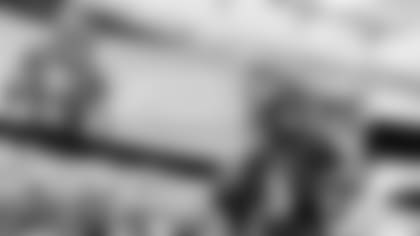Score one for the Ravens' philosophy of taking the best available player, regardless of position.
If you ever doubted whether they really do stick to that concept and instead slyly let immediate needs creep into their decision-making, they offered incontrovertible proof with their selection of linebacker C.J. Mosley in the first round of the 2014 NFL Draft Thursday night.
They had other, more pressing needs, for sure. They could use starters at right offensive tackle and free safety, for instance. Another playmaking pass catcher wouldn't hurt.
By the time they were on the clock with the No. 17 pick, the tackles they reportedly wanted, Notre Dame's Zack Martin and Michigan's Taylor Lewan, were gone. But the top two safeties in the draft class, Alabama's Ha Ha Clinton-Dix and Louisville's Calvin Pryor, were still available. So were a slew of talented receivers, led by Oregon State's Brandin Cooks.
Inside linebacker? Well, the Ravens used a second-round pick on Arthur Brown a year ago, and they just gave veteran Daryl Smith a reported four-year, $16.1 million deal a few months ago. It certainly wasn't a position that screamed dire need.
No matter.
Mosley was the highest-rated player on the Ravens' board – easily the highest, it seems. Ravens Assistant GM Eric DeCosta said Mosley would have been atop their board even if they had been picking at No. 10. That's quite a statement.
"C.J. was the clear-cut guy," GM Ozzie Newsome said.
So the Ravens took him.
They did it knowing that they would still have holes at right tackle and safety, and that they could still use another offensive playmaker as well as a third cornerback and, well, let's see, did I leave anything out?
But they simply didn't let those needs dictate their choice, instead taking a player they believe will be a major puzzle piece going forward.
It's a philosophy the Ravens have relied on many times, such as when they drafted running back Jamaal Lewis in 2000, tight end Todd Heap in 2001, defensive tackle Haloti Ngata in 2006 and running back Ray Rice in 2008. They seemed set at those positions in those years and certainly had other needs, but they went with players they thought would be major puzzle pieces going forward. It worked out well, to say the least.
In 2011, they drafted tight end Ed Dickson in the third round, and then took another tight end, Dennis Pitta, in the very next round because they judged him the best player available. It looked weird, but it worked out.
Does this mean the Ravens absolutely, positively were sure they would take Mosley when the opportunity arose Thursday night? No. Newsome admitted the Ravens also liked several players taken earlier in the first round.
"All of the players that went before us were players we would have considered at No. 17," Newsome said.
I'm guessing they would have had a tough choice if Martin, the plug-and-play tackle from Notre Dame, had been available. He was an especially great fit. But he went to the Dallas Cowboys at No. 16, right before the Ravens were on the clock. (The Ravens and Cowboys flipped for that pick at the combine, if you recall. As it turns out, losing that flip may have greatly impacted the Ravens' draft.)
Newsome also admitted the Ravens wanted to see what offers they received for the No. 17 pick once they were on the clock, intimating that they would have traded back if the right offer had come along.
But nothing knocked them out, so they looked up at their board and took what DeCosta called "a relentless, smart football player," one who will set up shop in the middle of their defense, right where Ray Lewis used to roam. It isn't a sexy pick and it leaves the Ravens with lingering needs that must be addressed starting with Friday's second and third rounds, but their board has spoken, and hey, strengthening the spine of your defensive unit is never a mistake.


















